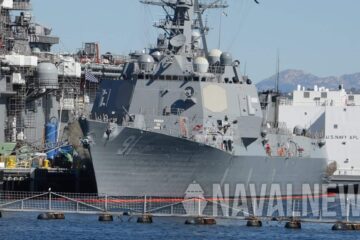The Department of the Navy released its strategic blueprint for the Arctic titled a Blue Arctic Jan. 5, delivering a regional outline spanning the next two decades as the Department continues to prepare for an increasingly accessible and navigable Arctic Region.
The forward-looking document provides strategic guidance on how the Department will apply naval power in the Arctic Region and stresses an approach that integrates American naval power with joint forces, interagency teammates, allies, and partners. It also challenges the Navy-Marine Corps-Coast Guard team to evolve and expand the range of integrated capabilities to achieve enduring national interests in the region.

A Blue Arctic provides the general idea that the Arctic is gradually turning from “White” to “Blue”— and by that, reduced ice coverage is making Arctic waters more accessible and navigable, which will enable nations and their navies to access new sea routes, resources, and markets.
The blueprint places focus on the rising maritime activity spurring from Arctic states, like Russia and China, which posture their navies to protect sovereignty and national interests while enabling their ability to project power.
The full strategic blueprint for the Arctic is available at this link.
Q&A with Timothy Choi, Specialist in Arctic and Maritime Security issues, Fellow with the Canadian Global Affairs Institute:
Naval News – Does this blueprint represents a significant doctrinal change for the United States ?
Timothy Choi – No, there’s very little in the new blueprint that’s actually “new”. Much of it is the *global* approach of the US Navy recast for the Arctic region, without much discussion for the very diverse range of naval challenges and requirements in the different areas of the Arctic. If one replaces all the mentions of “Arctic” in the document with “Indo-Pacific”, much of it would still make sense.
Naval News – Why is China mentioned as an Arctic state ? China’s borders are nowhere near the Arctic circle. China merely obtained a “permanent observer” status at the Arctic Council in May 2013.
Timothy Choi – The “China is an Arctic state” is clearly an error in the press release. It doesn’t show up in the actual document, so I wouldn’t take it too seriously and as anything other than a lack of proofreading.

Naval News – Unlike Russia, the US Navy currently lacks true surface combatants capable of arctic operations. Are the options outlined under “Build a More Capable Arctic Naval Force” enough to close the gap in your opinion ?
Timothy Choi – In short, no. No options are actually outlined. The document only serves to remind the navy that yes, Arctic conditions should be kept in mind when building future naval forces, without any indication on what kind of forces will be necessary. This is part of the problem with the “blueprint” – the Arctic is discussed in such general terms that it becomes impossible to give specific directions when it comes to force structure requirements and composition. For instance, the Russian submarine threat in northern Europe requires a very different set of capabilities than helping the coast guard monitor the EEZ off Alaska. Even worse, the USCG is only mentioned briefly even though any Arctic naval force development around North America would have to be done in close coordination with the USCG’s icebreaking capabilities. If a “blueprint” is supposed to describe in minute details the components of a completed ship design, this document is a long way from that and is closer to an initial Request for Information.






